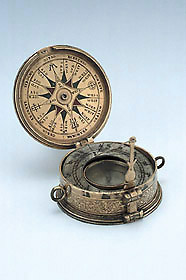
 |
| Catalogue |
 |
 Astronomical Compendium The front cover has a lunar volvelle marked 'INCREMENTVM ET DECREMENTVM LVNAE'. The volvelle has a circular aperture to reveal a diagram of the phases of the moon and a symmetrically engraved decoration of fruit and leaves. The volvelle's scale of hours runs 1 to 12, 1 to 12, divided to 1/4, with a hand pointer at 12 and an aperture at 6 through which a fixed scale of the age of the moon can be seen 0 to 28 [291/2]. The surrounding fixed scale of hours runs 1 to 12, 1 to 12, divided to 1/4. Beyond is a circular table whose divisions correspond to the scale for the age of the moon, and which gives the time difference between the positions of the sun and moon during the lunar month. The table gives the time interval in both hours ('HOR') and minutes ('MIN', with reversed N). The reverse of the front cover has a wind rose with the Italian names of the eight principal winds, given as 'TRAMONAN', 'GRECO', 'LEVANTE', 'SIROCHO', 'OSTRO', 'LEBECHIO', 'PONENTE' and 'MASTRO'. This circular scale surrounds a red and green enamelled compass rose pointing 16 directions. The directions are named or abbreviated in German and the four cardinal points have individual symbols. The north point has a fleur-de-lis, south is marked with an M for the meridian, east features an unusual design of four crosses at right angles to each other, while west has a double-ringed circle girdled by a band. The labelling of directions is not without problems: east by south east appears as 'OST N OST'; south by south east is 'SVD OST'; west by north west is 'WES S WEST'; and north by north west is simply 'NORT WES'. A central hole was intended to hold a wind vane which is now missing. The central box has an inclining dial, the hours of whose silvered dial plate run 4 to 12 to 8, with the hours from 6 to 12 to 6 divided to 1/4. The dial plate turns about an axis close to that notionally connecting the two suspension rings. The latitude scale is engraved directly on the inside of the central box's cylinder, giving the range 37 to 45? (at 2? intervals) when the dial plate is depressed at the north, and 45 to 55? (again at 2? intervals) when the dial plate is depressed at the south. The dial plate has two holes through which the string gnomon could be tied and is held at its other end by a folding support. There is a ring spring on the underside of the dial plate intended to keep the support vertical. The compass is visible through a circular aperture in the centre of the dial plate. The compass bowl is 27 mm in diameter and its silvered plate has a single line to indicate the magnetic meridian, offset eastwards from the geographical meridian to accommodate magnetic variation. A small projecting tongue on the underside of the compass bowl allows the magnitude of the variation to be adjusted within a limited range. No directions are named on the compass's base plate. The north end of the blued needle terminates in a T. Inside the back cover is a nocturnal with a decorated folding index. The nocturnal is intended for use with either of two stars whose marked index lines are, unusually, the only fixed part of the device. A star and line indicate both 'DVBHE VRSA MEIORIS' and 'KOAB VRSA MINORIS'. The hour scale on the volvelle runs 4 to 12 to 8, with studs for the hours before midnight and pointers for those after. Within the hour scale, which is cut away between 8am and 4pm, is the calendar scale in which the months are marked by their initial letters, except for 'IANA' and 'IVLI'. Each month is divided and numbered 10 (adjusted for the length of the month), and subdivided to 2. The back cover has a table of the latitudes of 24 places in the German lands, Italy, Spain, Portugal, France and England, as well as an entry for Constantinople. Although the instrument has been attributed to Christoph Schissler, there is little either decoratively or technically that directly recalls his work. Even the acid etching around the central box and on the underside of the compass bowl does not seem to use quite the same patterns as Schissler. Stephen Johnston |



